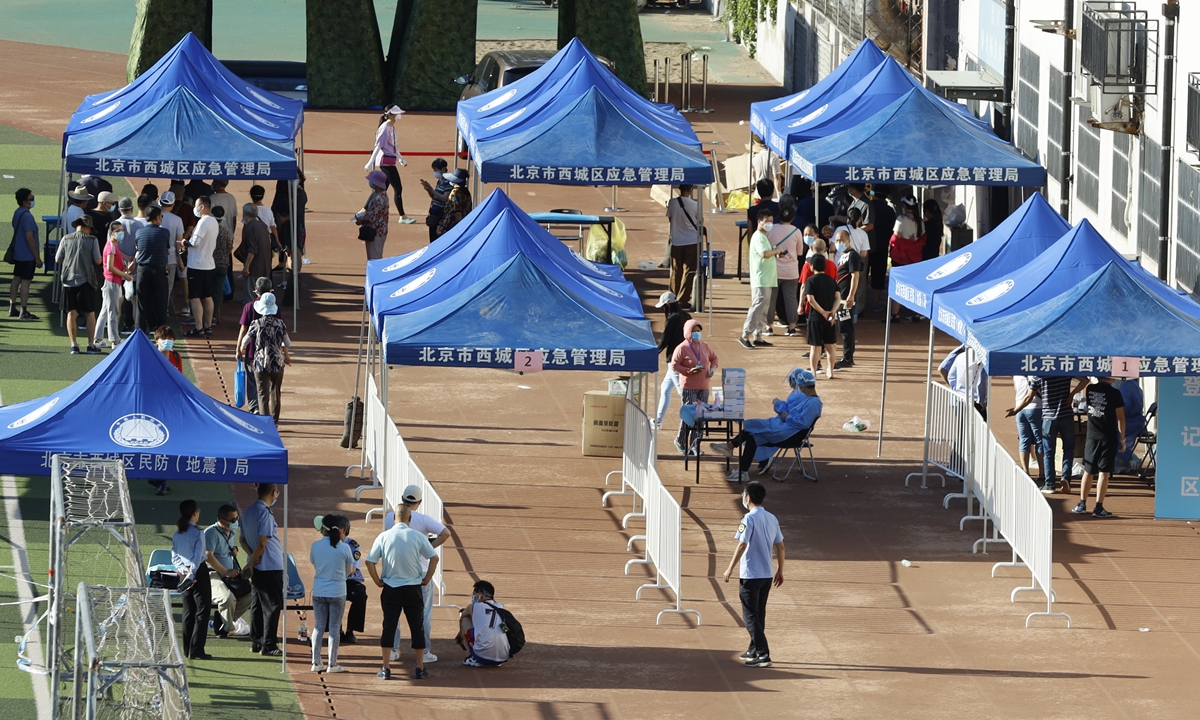Beijing, Washington respond to outbreak’s 2nd wave differently: Global Times editorial
Source:Global Times Published: 2020/6/16 22:03:40

Residents follow a health worker to a testing station at a sports center in Xicheng district after Beijing municipal government demanded all residents who visited the Xinfadi food market since May 30 to undergo nucleic acid tests for possible infection with the novel coronavirus after the city reported 51 confirmed COVID-19 cases as of Sunday. Photo: Li Hao/GT
With a new coronavirus outbreak in Beijing and the number of infected and hospitalized people in the US also on the rise as many states reopen, people have begun to worry about the second wave of infections.Once again, China and the US respond differently in the face of the epidemic. Beijing has acted swiftly. Although there are only dozens of new cases daily, Beijing has considered all risks of the spread of the virus and tried to contain it before it does. Beijing and Chinese society have confidence that the capital city will not become the second Wuhan.
But in the US, a second or even a third New York state may emerge. The situation in many states across the US is much more severe than in Beijing. The US still has about 20,000 new cases daily, with each state having 400 on average. In New York state, where the epidemic is believed to have been put under control, the number of new infections in the past 24 hours was 620.
Has the US federal government carried out any forceful measures to contain the virus? No. The White House has not released any policies or guidelines concerning the epidemic for some time. White House briefings have not been held since the end of April. What people hear most from the US federal government is to urge each state to resume work and production, and claim that no matter what happens, the US will not be closed again.
But COVID-19 is infectious everywhere. The virus in Beijing needs strong measures to be contained, and the same is true in the US.
China had basically cleared the coronavirus in the country until most recently. Beijing is like a blank sheet of paper that the virus can leave prints on. But in fact, that is how the virus is spreading in other parts of the world.
No pain, no gain; no action, no effect. The measures the capital is taking show that the virus will eventually be curbed here, while places that haven't taken corresponding measures will have to bear the price. Some societies can afford more infections and deaths. Although this will trigger a debate on humanitarianism, it's their choice.
Beijing has adopted a different philosophy and measures in terms of fighting the coronavirus from some other places in the world. This explains why China can bring the epidemic under control and has suffered fewer deaths, while the US and some other countries have experienced serious outbreaks and suffered great losses.
It's groundless for Washington to blame China for its failure to fight the epidemic. Now Beijing is quickly mobilizing the city to combat the outbreak, while Washington is emphasizing reopening, scoffing at scientists' call to continue to keep social distance.
China and the US will have contrasting results of the epidemic battle in the next one or two months. How can Washington blame China for the next wave of the epidemic and related losses that are likely to occur on its soil?
The dispute over who should take responsibility for the COVID-19 pandemic is odd, anti-scientific, and disregards the basic principles of fighting the pandemic. It's a buck-passing act driven by certain political calculations. It shows contempt for rationality in the 21st century, and will surely be poorly recorded in history.
Posted in: EDITORIAL